

By CLOUDER, FIONA .
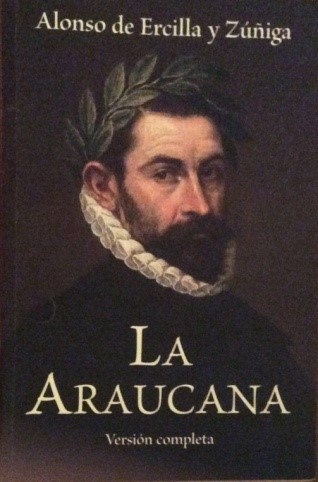 Accompanying Philip to the marriage celebrations in London was a page, Alonso de Ercilla y Zúñiga [tooltip title="2. Portrait by El Greco (1540-1614): The Poet, Alonso de Ercilla y Zúñiga, Hermitage Museum."](1533-1594).[/tooltip] Whilst in London, Ercilla was inspired by the tales of Gerónimo de Alderete of adventures in the New World. In October 1555 he joined Alderete on an expedition to Chile. As a soldier poet, Ercilla's great epic poem La Araucana, first published in full in 1590, documents the conquistadors in Chile and the fierce resistance by the indigenous Mapuche [tooltip title="3. de Ercilla y Zúñiga (1590): La Araucana."]people.[/tooltip]
Described as one of the greatest resistance wars in history, echoes still resonate today in Chile. Cervantes considered Ercilla to be one of the most talented poets of [tooltip title="4. de Cervantes, Miguel: Don Quijote de la Mancha, capítulo VI."] Spain,[/tooltip] and for the country La Araucana is an important document, both for its literary quality and its historical accuracy and portrayal of early Chile.
Also in 1555, Pedro Sarmiento de Gamboa (1532-1592) sailed for the New World. Growing up in Pontevedra, Galicia, in northern Spain, close to the point of the start and finish of the voyages of Columbus, Sarmiento became one of the leading explorers and navigators of his day. Sarmiento travelled extensively in what is today Mexico and Peru. He wrote a definitive account of the Incas, compiled through systematic interviews with local leaders and laws, and before finalisation included an unprecedented public reading to the indigenous authorities for comment and [tooltip title="5. Wikipedia."]correction.[/tooltip] By 1564 he had fallen foul of the Inquisition, including for use of astronomical rings, likely to have been navigation [tooltip title="6. Narratives of the Voyages of Pedro Sarmiento de Gamboa to the Straits of Magellan, Published by the Haykluyt Society."]aids.[/tooltip]
In 1578 the Spanish were concerned by the frequent attacks by Sir Francis Drake, along the South American coastline. In 1579 Sarmiento was charged by the ViceRoy of Peru to undertake a voyage of exploration to find new locations for possible garrisons to counter the English attacks, and to claim territory for the Spanish Crown. Caught in a storm on 21 January 1580, Sarmiento's ship Nuestra Señora de La Esperanza entered the Magellan Straits, emerging 34 days later on 24 February 1580. This was the second voyage to traverse the Straits from west to east and Sarmiento was the first to make a detailed survey and [tooltip title="7. www.memoriachilena.cl"]observations.[/tooltip]
Accompanying Philip to the marriage celebrations in London was a page, Alonso de Ercilla y Zúñiga [tooltip title="2. Portrait by El Greco (1540-1614): The Poet, Alonso de Ercilla y Zúñiga, Hermitage Museum."](1533-1594).[/tooltip] Whilst in London, Ercilla was inspired by the tales of Gerónimo de Alderete of adventures in the New World. In October 1555 he joined Alderete on an expedition to Chile. As a soldier poet, Ercilla's great epic poem La Araucana, first published in full in 1590, documents the conquistadors in Chile and the fierce resistance by the indigenous Mapuche [tooltip title="3. de Ercilla y Zúñiga (1590): La Araucana."]people.[/tooltip]
Described as one of the greatest resistance wars in history, echoes still resonate today in Chile. Cervantes considered Ercilla to be one of the most talented poets of [tooltip title="4. de Cervantes, Miguel: Don Quijote de la Mancha, capítulo VI."] Spain,[/tooltip] and for the country La Araucana is an important document, both for its literary quality and its historical accuracy and portrayal of early Chile.
Also in 1555, Pedro Sarmiento de Gamboa (1532-1592) sailed for the New World. Growing up in Pontevedra, Galicia, in northern Spain, close to the point of the start and finish of the voyages of Columbus, Sarmiento became one of the leading explorers and navigators of his day. Sarmiento travelled extensively in what is today Mexico and Peru. He wrote a definitive account of the Incas, compiled through systematic interviews with local leaders and laws, and before finalisation included an unprecedented public reading to the indigenous authorities for comment and [tooltip title="5. Wikipedia."]correction.[/tooltip] By 1564 he had fallen foul of the Inquisition, including for use of astronomical rings, likely to have been navigation [tooltip title="6. Narratives of the Voyages of Pedro Sarmiento de Gamboa to the Straits of Magellan, Published by the Haykluyt Society."]aids.[/tooltip]
In 1578 the Spanish were concerned by the frequent attacks by Sir Francis Drake, along the South American coastline. In 1579 Sarmiento was charged by the ViceRoy of Peru to undertake a voyage of exploration to find new locations for possible garrisons to counter the English attacks, and to claim territory for the Spanish Crown. Caught in a storm on 21 January 1580, Sarmiento's ship Nuestra Señora de La Esperanza entered the Magellan Straits, emerging 34 days later on 24 February 1580. This was the second voyage to traverse the Straits from west to east and Sarmiento was the first to make a detailed survey and [tooltip title="7. www.memoriachilena.cl"]observations.[/tooltip]
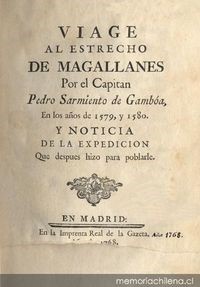 Sarmiento reported the results of the expedition to Philip II and recommended strengthening the defence of the Straits. In 1581 the King sent an expedition of 24 vessels with 2500 men, under the command of Diego Flores de Valdes. The aims were several - to transfer men to the Straits, to bring the new Governor of Chile. Alfonso de Sotomayor, and to bring a battalion of soldier to fight the war in [tooltip title="8. Eichmann Oehrli, Andrés and Zuleti Carrandi, Joaquin (2016): Edition and Translation of the Letter to Lord Burghley by Pedro Sarmiento de Gamboa."]Araucania.[/tooltip]
Sarmiento reported the results of the expedition to Philip II and recommended strengthening the defence of the Straits. In 1581 the King sent an expedition of 24 vessels with 2500 men, under the command of Diego Flores de Valdes. The aims were several - to transfer men to the Straits, to bring the new Governor of Chile. Alfonso de Sotomayor, and to bring a battalion of soldier to fight the war in [tooltip title="8. Eichmann Oehrli, Andrés and Zuleti Carrandi, Joaquin (2016): Edition and Translation of the Letter to Lord Burghley by Pedro Sarmiento de Gamboa."]Araucania.[/tooltip]
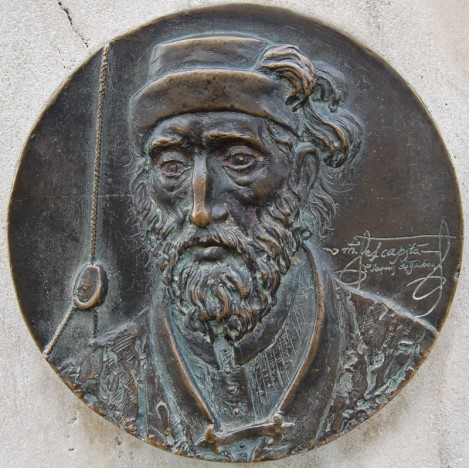 8 vessels were lost in a storm, 12 turned back to Spain at the entry to the Magellan Straits. With the remaining 4 vessels Sarmiento continued and on 5 February 1584, Sarmiento disembarked 300 men and founded the first settlement on Magellanic terrority, known as Nombre de Jesus. On 24 March, he founded a coastal garrison, known as Puerto de Don Felipe Rey, in honour of King Philip II.
Sarmiento de Gamboa sailed for Spain in 1584, and the garrison failed shortly after he left. He spent nearly year in Rio, seeking help for the community he had helped found in the Straits of Magellan. In January 1585 he took passage in a Brazilian ship bound for Spain to ask for the personal intervention of Philip II. His capture en route, meant this never happened. In 1587 Thomas Cavendish, one of the English 'pirates' landed and found the garrison had nearly all starved to death and renamed [tooltip title="9.Wikipedia."]it[/tooltip] [tooltip title="10. Fernánde, Cesáreo: Pedro Sarmiento de Gamboa, el navegante."]Port[/tooltip] [tooltip title="11. Solar, Ivor: Misery, despair and starvation at ‘Port Famine’ on the Strait http://www.digitaljournal.com/article/311099"] Famine.[/tooltip] As recorded in the diary of Charles Darwin, the highest mountain in Tierro del Fuego is named in memory of Sarmiento and his bravery, against insurmountable [tooltip title="12. Darwin, Charles: Beagle Diary."]odds.[/tooltip]
[caption id="attachment_22698" align="aligncenter" width="620"]
8 vessels were lost in a storm, 12 turned back to Spain at the entry to the Magellan Straits. With the remaining 4 vessels Sarmiento continued and on 5 February 1584, Sarmiento disembarked 300 men and founded the first settlement on Magellanic terrority, known as Nombre de Jesus. On 24 March, he founded a coastal garrison, known as Puerto de Don Felipe Rey, in honour of King Philip II.
Sarmiento de Gamboa sailed for Spain in 1584, and the garrison failed shortly after he left. He spent nearly year in Rio, seeking help for the community he had helped found in the Straits of Magellan. In January 1585 he took passage in a Brazilian ship bound for Spain to ask for the personal intervention of Philip II. His capture en route, meant this never happened. In 1587 Thomas Cavendish, one of the English 'pirates' landed and found the garrison had nearly all starved to death and renamed [tooltip title="9.Wikipedia."]it[/tooltip] [tooltip title="10. Fernánde, Cesáreo: Pedro Sarmiento de Gamboa, el navegante."]Port[/tooltip] [tooltip title="11. Solar, Ivor: Misery, despair and starvation at ‘Port Famine’ on the Strait http://www.digitaljournal.com/article/311099"] Famine.[/tooltip] As recorded in the diary of Charles Darwin, the highest mountain in Tierro del Fuego is named in memory of Sarmiento and his bravery, against insurmountable [tooltip title="12. Darwin, Charles: Beagle Diary."]odds.[/tooltip]
[caption id="attachment_22698" align="aligncenter" width="620"]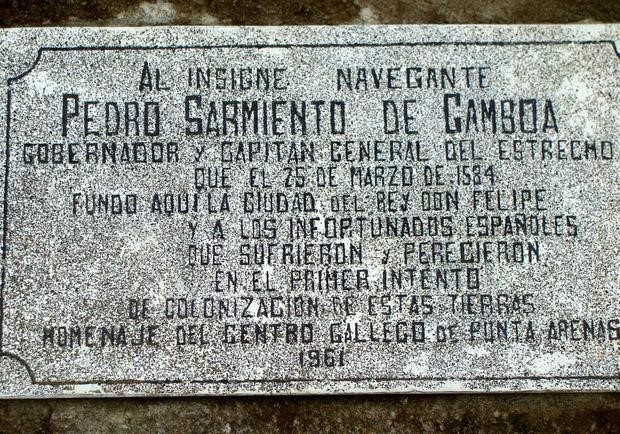 The commemorative plaque reads: "To the illustrious navigator Pedro Sarmiento de Gamboa, Governor and Captain General of the Straits who on March 25, 1584, founded here the city of Rey Don Felipe, and to the unfortunate Spaniards who suffered and perished in the first attempt to colonize this land. A tribute of the Galician Centre of Punta Arenas, 1961.
The commemorative plaque reads: "To the illustrious navigator Pedro Sarmiento de Gamboa, Governor and Captain General of the Straits who on March 25, 1584, founded here the city of Rey Don Felipe, and to the unfortunate Spaniards who suffered and perished in the first attempt to colonize this land. A tribute of the Galician Centre of Punta Arenas, 1961.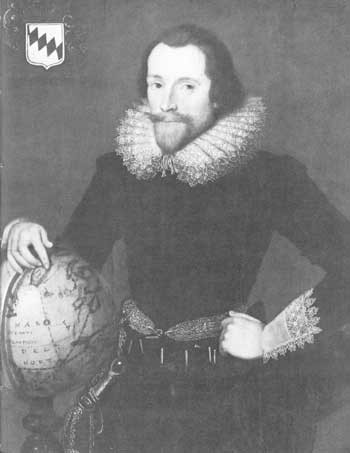 A portrait of Sir Walter Raleigh with a globe, attributed to Federico Zuccari (1542/1543–1609)[/caption]
Sarmiento was received with great courtesy by Sir Walter Raleigh and Queen Elizabeth I (sister and successor to Mary 1). This was in recognition that Sarmiento was one of the greatest navigators and sailors of Spain. It is reported that Sarmiento and the Queen conversed in Latin, as a common language, for two and a half hours. He was received as well by Lord Burghley, the advisor to the Queen, and by Admiral Lord Howard, by whom he was asked to convey a verbal message to King Philip of Spain, as a basis for [tooltip title="14. Calendar of Letters and State Papers Relating to English Affairs."]negotiation[/tooltip] and [tooltip title="15. Bulletin de la Real Academia de la Historia, Tomo XXVIII- Abril, 1898. Cuarderno IV. Informes. Pedro Sarmiento de Gamboa, El Navegante."]reconciliation.[/tooltip]
Sarmiento spent two months in England and is believed to have met with explorers and astronomers, and shared information with the English on the Southern Seas. His mark is said to be on the Molineux Globe, the first to be made in England; and on a map by Edward Wright, published in 1599 which corrected the form of South America. An annotation on the map [tooltip title="16. Eichmann Oehrli, Andrés and Zuleti Carrandi, Joaquin (2016): Edition and Translation of the Letter to Lord Burghley by Pedro Sarmiento de Gamboa."]stated:[/tooltip]
A portrait of Sir Walter Raleigh with a globe, attributed to Federico Zuccari (1542/1543–1609)[/caption]
Sarmiento was received with great courtesy by Sir Walter Raleigh and Queen Elizabeth I (sister and successor to Mary 1). This was in recognition that Sarmiento was one of the greatest navigators and sailors of Spain. It is reported that Sarmiento and the Queen conversed in Latin, as a common language, for two and a half hours. He was received as well by Lord Burghley, the advisor to the Queen, and by Admiral Lord Howard, by whom he was asked to convey a verbal message to King Philip of Spain, as a basis for [tooltip title="14. Calendar of Letters and State Papers Relating to English Affairs."]negotiation[/tooltip] and [tooltip title="15. Bulletin de la Real Academia de la Historia, Tomo XXVIII- Abril, 1898. Cuarderno IV. Informes. Pedro Sarmiento de Gamboa, El Navegante."]reconciliation.[/tooltip]
Sarmiento spent two months in England and is believed to have met with explorers and astronomers, and shared information with the English on the Southern Seas. His mark is said to be on the Molineux Globe, the first to be made in England; and on a map by Edward Wright, published in 1599 which corrected the form of South America. An annotation on the map [tooltip title="16. Eichmann Oehrli, Andrés and Zuleti Carrandi, Joaquin (2016): Edition and Translation of the Letter to Lord Burghley by Pedro Sarmiento de Gamboa."]stated:[/tooltip]
By the discoverie of S. Francis Drake made in the yeare 1577, the Streights of Magellane, as they are comonly called, seeme to be nothing els but broken land and islands; and the southwest coast of America called Chili was found not to trend to the northwestwards as it hath beene described but to the eastwards of the north as it is heere set domne, which is also confirmed by the voyages and discoveries of Pedro Sarmiento and M. Tho. Candish Aº 1587Sarmiento was charged with taking a 'message of peace' from Queen Elizabeth I to King Philip II of Spain. This is described in a letter from the Ambassador of Spain in France, Bernandino de Mendoza to [tooltip title="17. Letter from Bernardino de Mendoza a Felipe II. París, 8-I-1587. AGS, Estado, K, 1566, cited in 14. The diplomatic mission of Sarmiento had a clear objective: to pacify Philip II and to suspend the preparation of the Armada."]King[/tooltip][tooltip title="18. Bulletin de la Real Academia de la Historia, Tomo XXVIII- Abril, 1898. Cuarderno IV. Informes. Pedro Sarmiento de Gamboa, El Navegante."]Philip[/tooltip][tooltip title="19. Barros, Jose Miguel: Pedro Sarmiento de Gamboa: avatares de un caballero de Galicia."]II:[/tooltip]
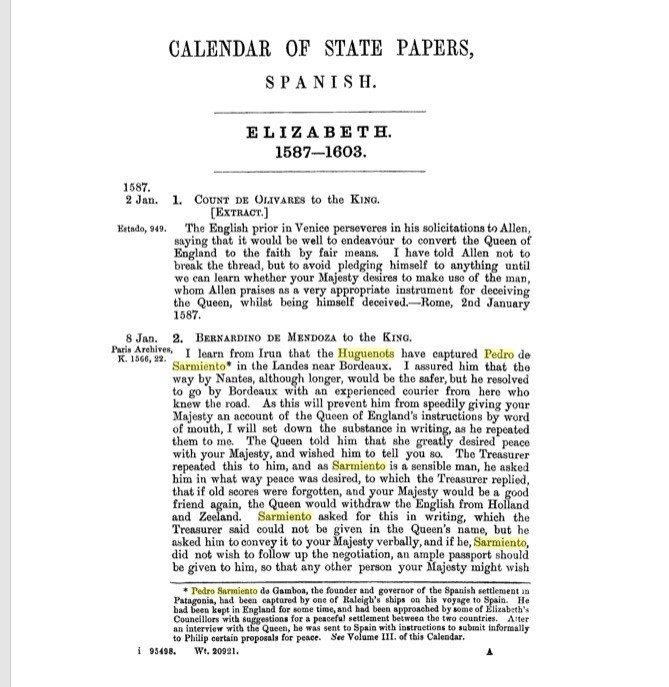
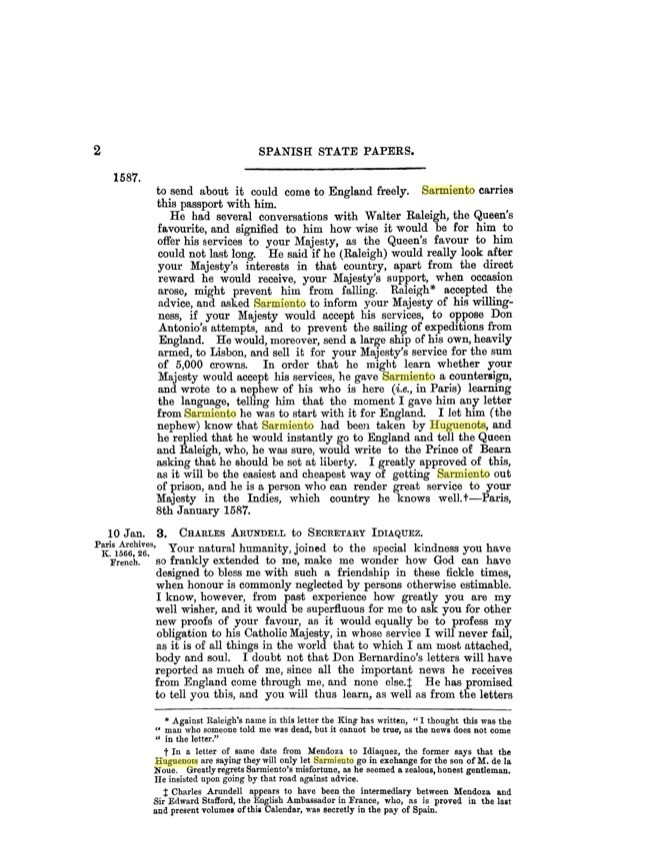
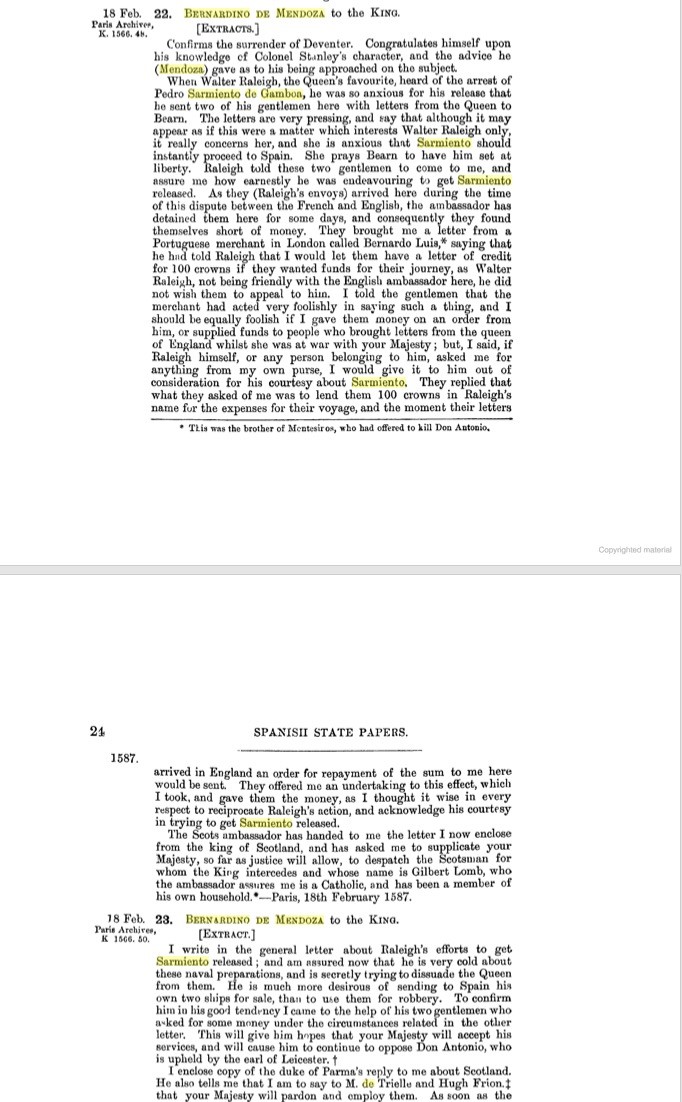 During his journey to Spain, Sarmiento was captured by French Huguenots, and imprisoned in Mont de Marsan for three years, until the middle of 1590. This was despite requests for his release from the Queen, Raleigh and others. On his release he returned to Spain. He subsequently wrote to Lord Burghley, the advisor to Queen Elizabeth, thanking him for [tooltip title="20. Eichmann Oehrli, Andrés and Zuleti Carrandi, Joaquin (2016): Edition and Translation of the Letter to Lord Burghley by Pedro Sarmiento de Gamboa."]his[/tooltip] [tooltip title="21. National Archives: Pedro de Sarmiento de Gamboa to Lord Burghley: SP 46/125/fo 160-161d."]help.[/tooltip]
[caption id="attachment_22700" align="aligncenter" width="717"]
During his journey to Spain, Sarmiento was captured by French Huguenots, and imprisoned in Mont de Marsan for three years, until the middle of 1590. This was despite requests for his release from the Queen, Raleigh and others. On his release he returned to Spain. He subsequently wrote to Lord Burghley, the advisor to Queen Elizabeth, thanking him for [tooltip title="20. Eichmann Oehrli, Andrés and Zuleti Carrandi, Joaquin (2016): Edition and Translation of the Letter to Lord Burghley by Pedro Sarmiento de Gamboa."]his[/tooltip] [tooltip title="21. National Archives: Pedro de Sarmiento de Gamboa to Lord Burghley: SP 46/125/fo 160-161d."]help.[/tooltip]
[caption id="attachment_22700" align="aligncenter" width="717"]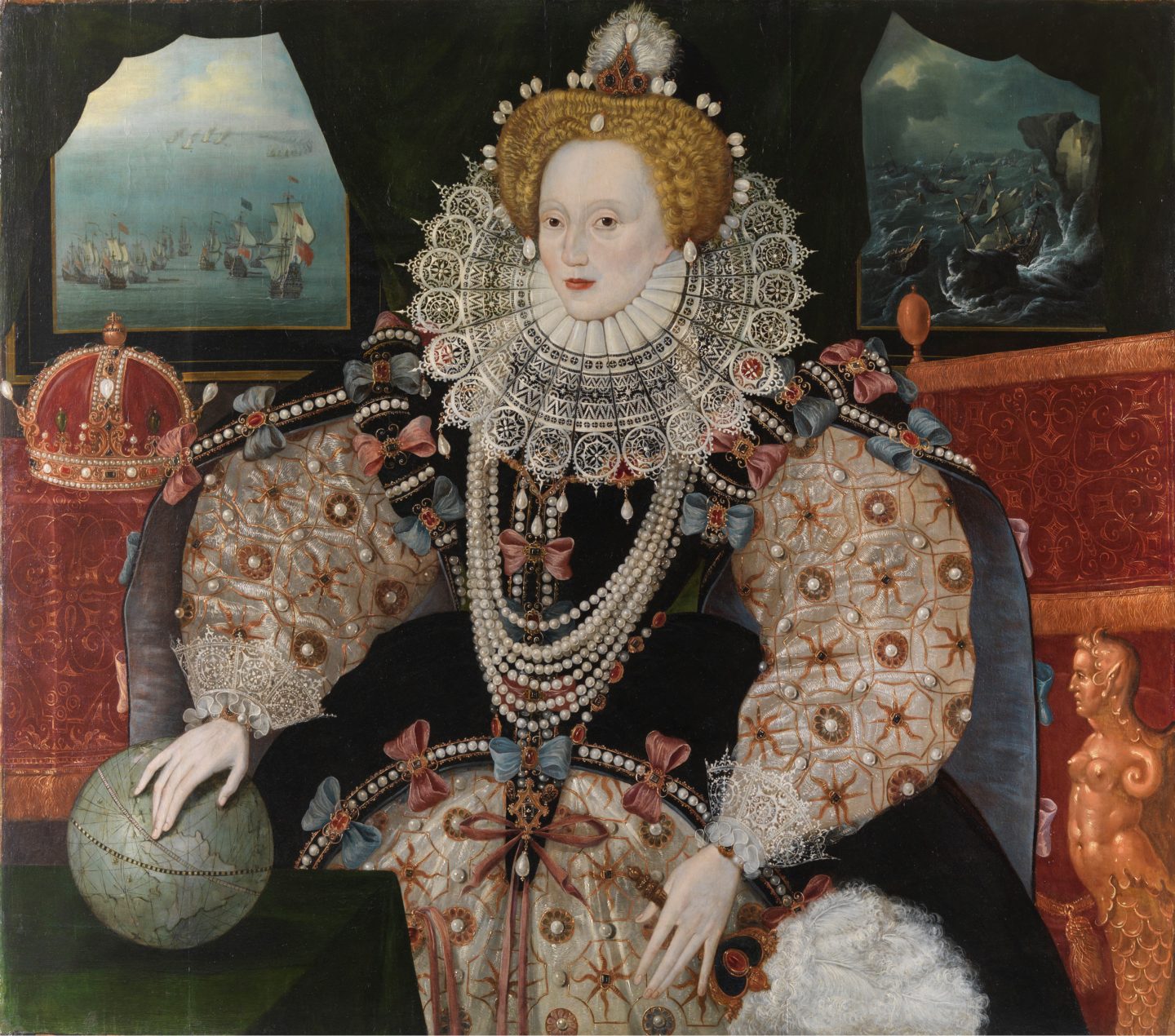 Elizabeth I, 1533-1603 (the 'Armada Portrait')
Elizabeth I, 1533-1603 (the 'Armada Portrait')Leadership development is considered an essential tool for success, both in military and civilian organisations. In times when adapting to change has become a continuous challenge, the Chilean Navy’s leadership development model might need to be analysed using the experiences of other navies and other Chilean civilian organisations. This essay summarises a research done as part of the MA ‘Leadership’, at the University College of London. It includes experiences obtained from the British Royal Navy, and the insights of a group of Chilean civilians and naval interviewees. The conclusions discuss about the key components that a leadership development programme in the Chilean Navy should have.
Richard Kouyoumdjian seeks to answer the question about if China is or not a Sea Power. After analysing what authors like Alfred Thayer Mahan have to say about this concept, he uses the more contemporary points of view of Geoffrey Till to define what kind of Sea Power a nation, particularly in this case China, has. Through the different chapters the author arrives to the conclusion that enables us to understand China ´s interests and how it will develop in the future and her relation with the US Naval Power.
Paul Carroll explains how the Royal Navy faces the big challenge of emissions control and environmental care. He foresees approaches reducing energy demands, more efficient machinery and power generator, application of emission control measures and the development of new technologies. Carroll´s conclusions consider the need of investing in new and innovative measures, including the adaptation of commercially available solutions, to comply with the increasing demand for better environmental protection, especially from Royal Navy units.
Versión PDF
Año CXXXX, Volumen 143, Número 1008
Septiembre - Octubre 2025
Inicie sesión con su cuenta de suscriptor para comentar.-